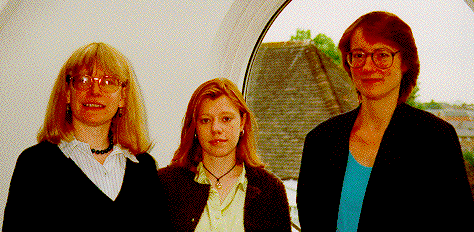Interface: EARL
Project EARL was established in 1995 with funding from the British Library, the Library Association and participating libraries, with the objective of developing 'the role of public libraries in a networked environment, within a collaborative framework'. The coordinating partner is the London and South Eastern Library Region (LASER). Frances Hendrix, Director of LASER, and Catherine Hume of EARL, were happy to fill me in on what public libraries are doing on the Internet at present.
Hendrix explained that at the time of EARL's inception, public libraries were not using the Internet for service provision to any great degree. LASER produced a study by Peter Stone, the EARL consultant, which looked into what was possible, what was available and what networking facilities libraries claimed they would like in the future. It became clear that the issue was basic survival. "At EARL we felt that, unless we took the initiative to try to get public libraries to use networked information, and to develop services for and with them, we would not be developing public libraries for the 21st century. They would become a backwater." LASER seized upon the arrival of Project EARL as an opportunity for an initiative which would demonstrate that public libraries were interested in the Net, and had a lot to offer.
Catherine Hume is EARL's Liaison and Development Officer. Derek Law's comments about public libraries in his article 'A MAN For All Reasons?' (ARIADNE issue 2) stung her into contacting us at the magazine. Eager to prove him wrong, she began by recounting what Project EARL and the libraries in the partnership have achieved. "We provide a focus for public library networking. Not only networking on the Internet - though obviously it is our greatest tool – but also the sharing of resources and ideas among Project partners."
 Derek Law warned public libraries to avoid turning into 'couch potatoes'. Hume points out that the Project has created a buzz around the UK from authorities keen to develop their networked services. The project currently has over 75 members, consisting of local public library authorities individually and in consortia, together with organisations such as UKOLN, eLib and the Library Association. It has its own Web pages. In addition to providing the world with information about EARL and its partners, links are provided from the list of partners to their own home pages. It lists the Internet services available within each of the local authorities involved. "If you want to know what Hertfordshire, or Croydon, or Solihull are doing with the Net, try the EARL home page."
Derek Law warned public libraries to avoid turning into 'couch potatoes'. Hume points out that the Project has created a buzz around the UK from authorities keen to develop their networked services. The project currently has over 75 members, consisting of local public library authorities individually and in consortia, together with organisations such as UKOLN, eLib and the Library Association. It has its own Web pages. In addition to providing the world with information about EARL and its partners, links are provided from the list of partners to their own home pages. It lists the Internet services available within each of the local authorities involved. "If you want to know what Hertfordshire, or Croydon, or Solihull are doing with the Net, try the EARL home page."
EARL also gives its partners space on its server to mount their own pages. This is what the Project was established to provide. EARL wants all its members to have a Web presence and can give professional advice on page construction and design. As Hume explained, the picture is patchy. Some services have had Internet access since the early nineties – others are still waiting to be connected. It is one of Hume's jobs to keep in touch with members and chart their progress towards the goal of full connectivity and Web existence.
EARL also acts as a consortium broker with Internet suppliers on behalf of its members, and has successfully arranged a discount for members with PIPEX. E-mail accounts can be supplied where necessary, and a regular newsletter is produced (in print and over the Net). The Project has assisted public libraries to reach the point where the power of the Net for communications has become evident. Net-based surveys are now common. A recent example was a survey of unique special collections in member authorities. From this, a catalogue will be built, and the eventual aim is to digitise some of the collections. More prosaically, partners are also surveyed for information on their levels of connectivity (the British Library will require a report at the end of the contract).
The Project is now moving into its second phase, and is applying to the British Library for further funding to support Task Groups. These focus on areas where partners perceive potential for co-operative resource-sharing. Subject-based gateways to resources, a familiar topic in the eLib world, are under development.
eLib has recently become an associate partner in EARL. Hume is enthusiastic. "eLib is so far advanced in what it provides both for research initiatives and training that we feel we can only learn from it."
EARL is ambitious for the public library sector. University libraries have surged ahead in networked information provision, largely though the easy availability of a high-speed network, which has been developed over the years into perhaps the best example of its kind in the world. For public libraries, the journey has been much harder. Without the physical infrastructure and collaborative funding at the service of strategic vision, the sector has lagged far behind. But the existence of EARL testifies to the desire of the sector for progress, and MANs offer an infrastrucure of immense potential, as Law's article pointed out. He also asked "where on earth have been the UK equivalents of the pioneers … in Colorado who developed Maggie's Place a decade ago?". Suffering in our own Maggie's Place, they might answer. But emerging at last.
